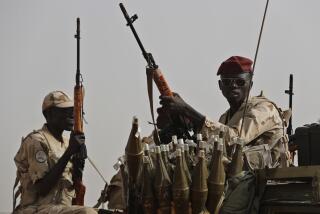Rwandans Flee After 2,000 Die in Camp Melee : Africa: Army’s attempt to order refugees home results in tragic reversal for reconciliation efforts.
KIGALI, Rwanda — Tens of thousands of Rwandan refugees escaped down rain-slicked roads and into the soggy hills in panic Sunday after the army shut down their camps inside Rwanda--leaving an estimated 2,000 shot, trampled or butchered to death.
The army ordered the refugees to return to their former homes, promising them peace. But U.N. officials said many of those who tried to go home were pelted with stones and attacked.
Not since the end of the civil war in July has such violence occurred on Rwandan soil:
* At least 250 children were abandoned in the chaos and collected by relief workers.
* About 650 people were treated for injuries and wounds.
* Rwandan soldiers, assisted by U.N. troops, buried most of the dead in hastily dug mass graves.
In the process, Rwanda’s emerging efforts at national reconciliation suffered a tragic reversal--perhaps foreshadowing even worse consequences for its suffering people in the months ahead.
“A total tragedy,” said an official at U.N. headquarters here.
The death toll from three days of conflict at a refugee camp in southwest Rwanda remained a gruesome guessing game. Throughout the day Sunday, the United Nations said its field reports indicated that 4,000 may have died--the result of soldiers firing on refugees, of refugee thugs killing other refugees with machetes and of people being crushed by stampedes.
But late in the day, the U.N. military commander for Rwanda, Maj. Gen. Guy Tousignant, said that the earlier estimate had been inflated as a result of confusion.
“I’ve just been informed that the revised figure would be closer to 2,000 people that have been counted by those who have been able to observe what happened there,” Tousignant told The Times.
Rwandan President Pasteur Bizimungu toured the Kibeho refugee camp Sunday and insisted that only 300 had died there.
“The figures that have been given have been exaggerated,” he told reporters. But he defended the army’s attack on the mass of refugees Saturday, saying that radicals among the refugees had instigated the killings. “People in the camp had arms and were violent. It’s a pity that people died,” he said.
A week ago, the hillside camp was semi-permanent home to 80,000 to 100,000 Hutus. On Sunday, fewer than 1,000 remained.
Several thousand refugees fled to the city of Butare, where they took shelter in the soccer stadium. The United Nations reported that 10,000 more have massed at various aid points in the region. As for the rest, some tried to return to their homes in the nearby countryside and many thousands more melted into the banana groves and cane fields of rural Rwanda.
“Those who tried to go home were not well treated. They were stoned by others; they were attacked and abused,” said the U.N. special representative to Rwanda, Shaharyar Khan.
A year ago, the majority Hutus controlled Rwanda’s elected government. But the death of their president in a mysterious plane crash April 6, 1994, triggered what is now regarded as a systematic genocide of half a million minority Tutsis.
The slaughter, however, did not stop a rebel Tutsi-led army from taking control of the country and driving Hutus into a mass refugee exodus. Most of the Hutu refugees left Rwanda for camps in neighboring countries. But 80,000 or so stayed in Kibeho and tens of thousands more in three other camps in southwest Rwanda.
At first they were shielded by French troops and then by the United Nations. Recently, however, the army decreed that there was no more need for these camps, and their occupants were told that it was safe to return home.
More to Read
Sign up for Essential California
The most important California stories and recommendations in your inbox every morning.
You may occasionally receive promotional content from the Los Angeles Times.










